![]() 1st Battalion 22nd Infantry
1st Battalion 22nd Infantry ![]()
The 22nd Infantry 1890 - 1897
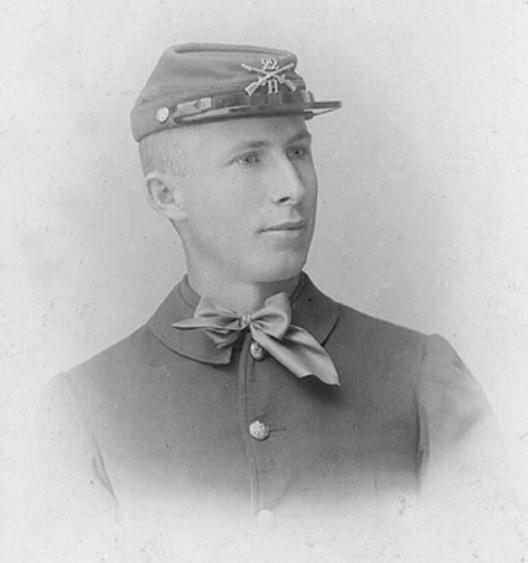
Photo of a Soldier of Company H 22nd
Infantry
He wears the model 1872 forage cap. The blue scarf is not
regulation.
Photo taken by L.A. Huffman, Miles City, Montana, during the time
the Regiment
was statoned at Fort Keogh.
In July, 1890, company E changed station from
Fort Totten to Fort Buford, N. D.
Pursuant to G. O. 76, headquarters of the army, July 21, 1890,
companies I and K were skeletonized and ceased to exist,
except on paper. The officers were assigned to companies,
replacing absent officers; the enlisted men were transferred to
other companies;
and the company records were laid away in the archives of the
adjutant's office.
In November, company G changed station from
Fort Totten to Fort Yates, N. D.
The companies were not in the "coffee cooling"
business, but were from time to time scouting or camping at
agencies where the Indians were restless
or were thought to be preparing "to go on the warpath."
In the latter part of 1890, there was an uprising of the Indians
at Pine Ridge
and Rosebud agencies, South Dakota. Companies A, B, D, G, and H
were ordered into the field and campaigned more or less all of
that winter,
sometimes in very inclement weather. Company D, under command of
Lieut. J. G. Ballance, made an extraordinary march to the relief
of Captain Fountain's troop, 8th cavalry, reported to have been
surrounded by 500 Indians at Cane hills, South Dakota.
December 23, at 7:45 p. m., it started upon its march in a wind
and snow storm, from Beisigl's ranch, reaching New England city,
a distance of sixty-three miles, at one o'clock a. m., the 25th.
It was necessary to make a halt there to rest and thaw out the
half-frozen men.
In a few hours the march was continued twenty-two miles, when a
portion of Captain Fountain's troop was met. The safety of the
troop was reported,
and the company then returned to New England city.
In the mean time companies C and K
had hard duty at the Cheyenne agency Montana. Early that morning several of the Sioux
had entered his camp and held a friendly talk with him. Casey was a brave and energetic
officer, and an enthusiastic friend of the Indian. ( Ed., 1st Lieutenant Edward W. Casey
graduated from the U.S. Military Academy |
1st Lieutenant Edward W. Casey |
Some time after the close of the hostilities
the companies returned to their station—July, 1891, found
them all back at their posts.
The Cheyenne Indians on the Tongue river agency were at this time
always more or less restless, making it necessary to keep
at least one company at the agency practically all the time. In
December, 1890, troop G, 1st cavalry, was relieved by company F,
22nd Infantry.
Company F was relieved by company C in April, and the latter
company was withdrawn in May, 1891.
In April, 1891, company I was designated as an Indian company;
the station was changed to Fort Yates, N. D.,
and it was given an authorized strength of fifty-five Sioux
Indians.
During the summer of this year, company A was
transferred from Fort Abraham Lincoln, company G, from Fort
Yates,
and company E, from Fort Buford, to Fort Keogh for station. In
making this change, company E marched overland.
This now brought the entire regiment, with the exception of the
Indian company at Fort Yates, together at Keogh—
the first time in the history of the regiment.
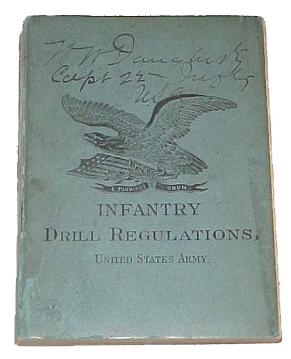
US Army Infantry Drill Regulations,
Revision of 1891
belonging to Captain William W. Daugherty of the 22nd Infantry
In December of 1891, the Northern Cheyennes on
the Tongue river agency again became restless, and company A was
sent out.
The old temporary camp, known as Camp Crook, south of the agency,
was abandoned and a camp site near the agency was selected
and named Camp Merritt, after the then department commander. The
company began the erection of log quarters for the officers and
enlisted men,
although it was in the coldest part of a severe winter. While
engaged in this work, 2nd Lieut. W. E. Bruce, due to the
exposure,
contracted pneumonia, from which he died on February 27, 1892. He
was a young officer of promise, and his death was a loss to the
regiment.
The quarters at Camp Merritt were in due time completed, and a
garrison of one company, changed every three months from Keogh,
was maintained there as long as the 22nd remained at Keogh.
On July 13, 1892, a telegram from department
headquarters directed that all of the regiment available be sent
immediately
to the scene of the mining riots in the Coeur D'Alene region in
Idaho. The telegram was received at 4 o'clock p. m., and at 9.30
p. m.
companies B, D, F, G, and H were at the railroad station,
equipped for thirty days' field service and ready to embark for
the scene of the trouble.
Upon arrival in the Coeur D'Alenes, July 15, the command was
divided between Wallace and Mullan, and for the two weeks
following,
was actively engaged in preserving order, guarding mines, and
assisting in the arrest of the leaders in the riot. This duty
continued until July 27,
when, order having been restored, the command was relieved and
started on its return trip to Fort Keogh.
"CAMPAIGN DRESS,
1887-91 His bugle is carried on a
tasseled cord in infantry white, His 1887 Mills Infantry
cartridge belt fastens with the ( Ed., the illustration shows
the field dress worn by Illustration by Richard Hook From the book: US Infantry in the Indian Wars 1865-91 By Ron Field, Osprey Publishing Ltd. 2007 |
|
Ed., The following duties of the 22nd Infantry
were reported to the Secretary of War in the 1893 annual report
of Brigadier General Wesley Merritt, Commanding Officer of the
Department of the Dakotas:
August 25,1892.—Company H, Twenty-second
Infantry, Capt. H.H. Ketchum,
commanding, left Fort Keogh, en route to Camp Merritt, near
Tongue River Agency,
Mont., for a tour of duty there, and to relieve company C,
Twenty-second Infantry, from
duty at that camp. Arrived August 31. Distance marched, about 90
miles.
September 1,1892.—Company C, Twenty-second
Infantry, Capt. P. M. Thorne,
commanding, upon being relieved by company H, Twentysecond
Infantry, left Camp
Merritt, near Tongue River Agency, Mont., and returned to its
station, Fort Keogh, Mont.
Arrived September 6. Distance marched, 95 miles.
September 12, 1892.—Company I, Twenty-second Infantry,
Second Lieut. William H.
Wassell, commanding, left Fort Yates, N. Dak., and proceeded on a
tour of recruiting
duty for the company, visiting points on the Grand River and Rock
Creek, North Dakota.
Returned to post September 24. Distance marched, 109 miles.
November 29,1892.—Company H, Twenty-second Infantry, Capt.
H. H. Ketchum
commanding, on being relieved by Company A, Twentyfifth Infantry,
left Camp Merritt,
Mont., and returned to its proper station, Fort Keogh, Mont.
Arrived December 3.
Distance marched, 90 miles.
( Ed., The Panic of 1893 resulted in a country
wide depression which lasted for four years.
In 1894 the populist Jacob Coxey called for all unemployed
workers throughout the country to march on Washington D.C.
to protest the unemployment and to lobby the government to create
jobs. Coxey's followers became known as his "Army".
By far the largest single gathering of Coxey's "Army"
formed in the Pacific Northwest under the leadership of
William Hogan, and numbered some 500 men. They easily intimidated
and brushed aside all local and federal law enforcement
attempts to curtail their activities. The governor of Montana
called upon President Cleveland for Federal military assistance.
The Department of the Dakotas directed the 22nd Infantry to act
upon the President's orders.)
April 25, 1894, companies A, B, C, D, F, and H
left Fort Keogh, under orders to intercept and arrest the Hogan
division of Coxey's army.
This contingent of the unemployed had been organized in Helena
and Butte, Montana; their aim was to reach Washington
and join the main corps of Coxey's army. Although carrying no
firearms of any kind, there had been more or less trouble between
them
and the civil authorities. Matters reached a crisis when the
Hoganites seized a train of cars on the Northern Pacific road
and completely blocked all traffic on the line. Mails were
delayed for several weeks; the entire northwest was paralyzed by
a few hundred men.
When the regiment received its orders, the most alarming rumors
were rife—the men were desperadoes, they were fully armed,
they had murdered and robbed peaceful citizens. On the evening of
April 25, orders were received to hold the regiment at the
railroad station
at Keogh, ready to embark at a moment's notice on a special
train. Shortly afterward came word that the army was at Forsyth,
forty-two miles west of Keogh, getting an engine from the
roundhouse to continue their journey eastward.
Immediately after came orders to intercept the army before it
could leave Forsyth.
Then followed a long-remembered ride. In box
cars, over a rough stretch of railroad that was full of curves,
the six companies
were rushed at full speed of the engines. Some minutes before, at
the far end of the single track, desperate men were struggling
for an engine;
they were in ignorance of the regiment's order to intercept them;
if the west bound train did not reach Forsyth
before the east bound train was off the siding, a collision was
inevitable. Fortunately the suspense was soon over.
Just as the Hogan engine was ready to pull out, the regiment's
train dashed in. The Coxey engineer was knocked from his cab
and four hundred and eighty quiet, unarmed, unresisting prisoners
were surrounded by a chain of soldiers. The "army" was
so glad
to surrender to forces of the United States that, during the
night, a number that had not been captured beat their way into
the enclosure of sentinels
by concealing themselves on switching engines. A zealous officer
of the guard was made glad on the following morning when he was
able to turn over
more prisoners than he had received. The Coxeyites were taken
back to Helena, where companies A, C, and H acted as a guard over
them
until July 26. In the meantime the remaining companies were
guarding bridges, tunnels, and trains.
|
Lieutenant Colonel John H.
Page, |
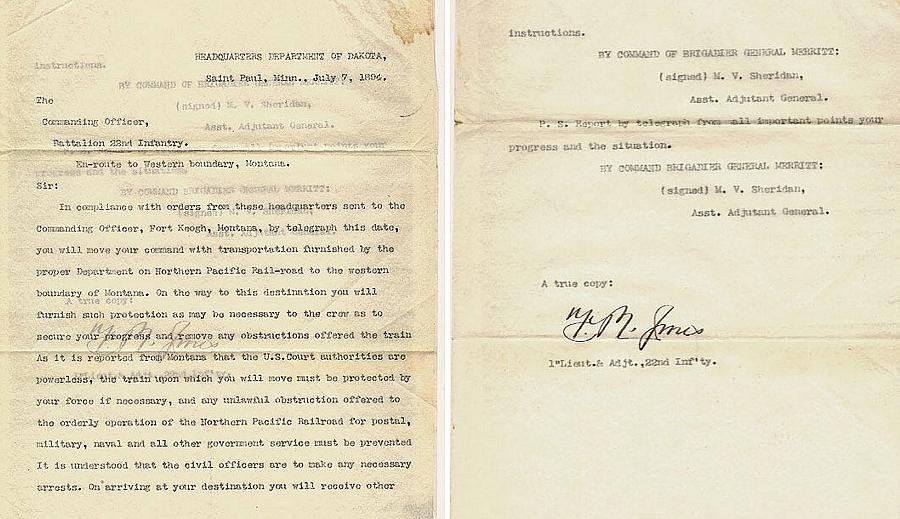
Order sent by telegraph from Brig.
General Wesley Merritt to LTC Page,
instructing him to use his command to protect the Northern
Pacific Railroad.
After the detention of the Hogan contingent of Coxey's
"Army" it was feared
that a sympathetic population might cause disruption of railroad
services,
in conjunction with the Pullman Strike which began in May and
June of 1894.
The order is signed by the Regimental Adjutant, 1st Lieutenant
F.B. Jones,
who was Regimental Adjutant of the 22nd Infantry from January 16,
1892 to January 16, 1896.
As result of a fire at Fort Keogh on December
30, 1894, which totally destroyed two sets of barracks, companies
B and D
were transferred to Fort Assiniboine, Mont., for station,
arriving at that station, January 19, 1895.
In August, 1895, Company E, which had been sent to Fort Pembina,
N. D., in the autumn of 1892, for station, was transferred
to Fort Assiniboine, and Pembina was abandoned. In September,
company A from Fort Keogh and D from Fort Assiniboine
were transferred to Fort Yates, and companies B and B from
Assiniboine to Fort Harrison. These latter were the first troops
to garrison Harrison, the new post at Helena, Mont.
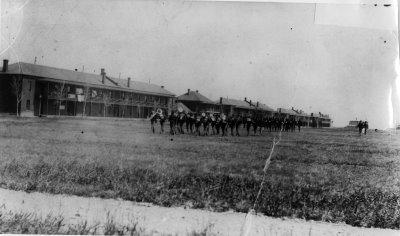
The parade ground at Fort Assinniboine,
Montana.
The fort was 38 miles from the Canadian border.
In 1896, the regiment lost two officers by
death. On February 16, 1st Lieut. John H. Wills died at
Asheville, North Carolina, and on April 15,
at Fort Yates, 2nd Lieut. H. G. Hambright was thrown from a horse
and killed. The death of these officers was greatly regretted by
all in the regiment.
In June, 1896, the long period of frontier service was broken and
the regiment made glad by orders sending it to the new post, Fort
Crook,
near Omaha, Nebraska. The entire regiment arrived at Fort Crook,
June 29, and all were happy to be stationed together.
All were soon comfortably settled in the fine new quarters and
entered upon the longest period of garrison service and unbroken
quiet
experienced by the entire regiment since its organization. With
the exception of practice marches, occasional encampments with
national guard
or G. A. R. organizations, this quiet continued until the
beginning of the Spanish-American war in 1898.
1st Lieutenant John H. Wills Assigned to the 22nd Infantry
upon graduation Wills contracted typhoid fever
during his long He died at Asheville, North Carolina on February 16, 1896. Photo from the U.S. Military Academy |
2nd Lieutenant Horace G. Hambright Assigned to the 22nd Infantry
upon graduation He was on Detached Service with
Casey's Scouts He would later have a coastal
artillery battery Photo by KatherineLynnNobles from Ancestry.com |
The entire regiment went to Chicago in July,
1897, to participate in the exercises attendant upon the
unveiling of the Logan monument,
and in September of the same year participated in the parade in
Omaha at the opening of its fair.
In all these years, the regiment led an active life. During
Indian campaigns, mining troubles, and railroad strikes, it had
done its full share of good work.
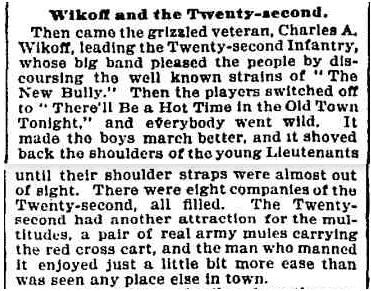
Above: From the Chicago Tribune Friday, July 23, 1897
As part of the festivities concerning
the unveiling of the Logan monument in Chicago in July 1897 a
massive parade was organized which included
several Army regiments, National Guard and Militia formations,
Fraternal organizations, Veterans organizations and even several
"battalions"
of Letter Carriers headed by the Postmaster of Chicago. The above
clipping from an article in the Chicago
Tribune described the 22nd Infantry's
part in the parade.
From the Chicago Tribune website
[ The occasion of the regiment's assuming a
garrison status at Fort Crook, Nebraska, in June, 1896, marked
also a culmination
of a long, active and arduous period of service on the vastly
extended Western frontier. During this time the battalions,
companies
and detachments of the regiment had marched and fought over many
thousands of miles of hitherto unexplored country.
The success of the widely varying missions of the command speaks
for itself, and, in accordance with the basic principles of
warfare,
can only be attributed to the high state of esprit, training and
morale of officers and men. In the course of these years the
casualties
in the regiment had fortunately been small, but to those few who
gave their lives in the operations involving the pacification
of the powerful and sometimes unruly tribes of the Indians, and
the upholding of law and order in the remote fastnesses of the
early West,
the great body of American citizens must award both honor and
gratitude for their services in behalf of the progress of
American civilization.1 ]
Ed., During the years 1890-1897 the following
Officer promotions and appointments were made
in the 22nd Infantry:
CAPTAIN
William H. Kell ..... 19 May 1891
John G. Ballance ..... 14 January 1892
Alfred C. Sharpe ..... 1 February 1893
John J. Crittenden ..... 6 June 1894
Theodore Mosher ..... 29 December 1894
Robert N. Getty ..... 17 March 1896
Frank B. Jones ..... 1 May 1896
FIRST LIEUTENANT
Tredwell W. Moore ..... 30 September 1891
William M. Swaine ..... 29 November 1892
George J. Godfrey ..... 1 February 1893
Herman Hall ..... 8 June 1894
Harold L. Jackson ..... 17 march 1896
SECOND LIEUTENANT
Charles H. Bridges ..... 11 June 1897
**********************
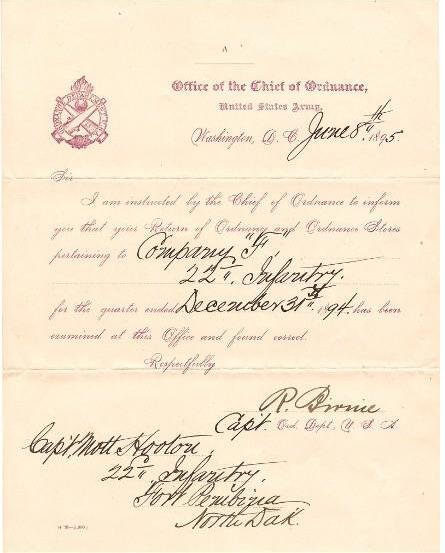
Letter from the Army's Ordnance
Department in Washington
to Captain Mott Hooton of the 22nd Infantry, dated June 8, 1895.
At the time CPT Hooton was Commanding Officer of F Company, and
was at Fort Pembina, North Dakota.
The fort was situated at the junction of the Pembina and Red
Rivers, right on the border of North Dakota and Canada.
Most of the fort was destroyed by a fire in May of 1895, and the
post was abandoned in August of that year.
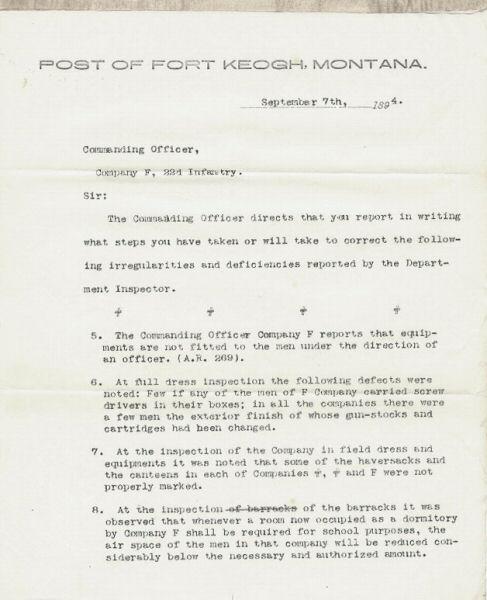
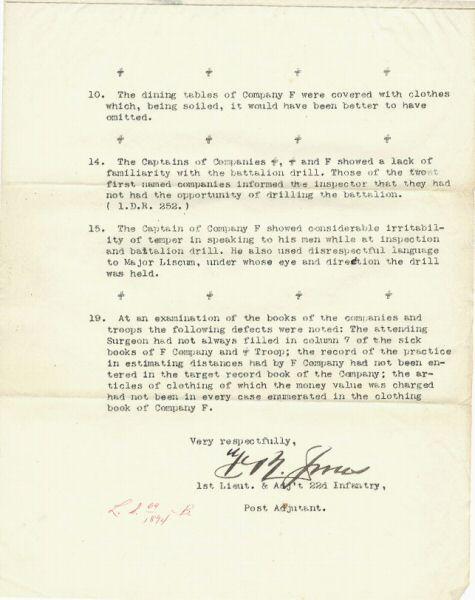
During a Department of the Dakotas
inspection of the post in 1894, a number of deficiencies were
noted
by the Department Inspector. Those pertaining to Company F were
pointed out in this letter of September 7, 1894,
to Company F's Commanding Officer, sent by the Post Adjutant, 1st
Lieutenant F. B. Jones.
|
"Skates" mascot
of Company F at Fort Crook. |
During the years 1890 to 1898
the following losses were incurred by the 22nd Infantry.
Places of birth are listed when known.
KIA = Killed In Action
DOW = Died Of Wounds
DOD = Died Of Disease
( A catch-all phrase used in the 19th Century to denote any
non-battle death)
Company A
John Ahern.....08/18/1891 -
Private - DOD - Kerry County, Ireland - Suicide
William Estcourt Bruce.....02/27/1892 - 2nd Lieutenant - DOD -
Pennsylvania - Died from typhoid fever at Fort Keogh
Thomas J. Dennehy.....02/21/1894 - Private - DOD - Cahersiveen,
Ireland - Died of tuberculosis
William Smith.....03/14/1896 - Private - DOD - New York, New York
- Died of endarteritis of the cerebral vessels
Horace G. Hambright.....04/15/1896 - 2nd Lieutenant - DOD -
Loudon County, Tennessee - Thrown from a horse and killed
Company B
Calvin R. Darnall.....05/06/1892 - Private - DOD - Wilkes County, North Carolina - Died of pistol shot wound
Company E
Peter T. Murphy.....05/29/1892 -
Private - DOD - Roscommon County, Ireland - Died of chronic
myelitis
Franz Albrecht.....07/31/1895 - Private - DOD - Bavaria, Germany
- Died of alcoholic poisoning
Albert L. Johnson.....07/31/1895 - Private - DOD - Worcester,
Massachusetts - Suicide
Edward L. Ledoux.....12/05/1895 - Private - DOD - Northhampton,
Massachusetts - Died of peritonitis
Company F
Joe Ferguson.....09/15/1897 - Private - DOD - Kentucky - Died of inflammation of the stomach
Company G
Henry Sanderson.....03/10/1891 -
Private - DOD - Burlington, Vermont - Drowned
Charles Braitsch.....07/08/1893 - Private - DOD - Obendorff,
Germany - Died of heart failure
Company H
Edward Wanton
Casey.....01/07/1891 - 1st Lieutenant - KIA - Benicia, California
- Killed by Indian near Brule Sioux Agency - Commander of Casey's
Scouts
Austin McDonald.....09/14/1892 - Sergeant - DOD - Murdered by
Private John Conley of Company H while on detached service at
Rosebud, Montana
Company I
John H. Wills.....02/16/1896 - 1st Lieutenant - DOD - Virginia - Died of tuberculosis
Band
Christian Mouw.....05/19/1896 - Private - DOD - Zevenbergen, Holland - Suicide
**********************
The above narrative is taken from the 22nd
Regimental History compiled in 1904
under the direction of Captain R.L. Hamilton
1 From the 22nd Regimental History
compiled in 1922
under the direction of Captain G.C. Graham
( Ed., ) Notes and comments from the website editor
Additional information taken from:
Returns from Regular Army Infantry
Regiments, June 1821–December 1916. NARA
microfilm publication M665
National Archives and Records Administration, Washington, D.C.
Home | Photos | Battles & History | Current |
Rosters & Reports | Medal of Honor | Killed
in Action |
Personnel Locator | Commanders | Station
List | Campaigns |
Honors | Insignia & Memorabilia | 4-42
Artillery | Taps |
What's New | Editorial | Links |